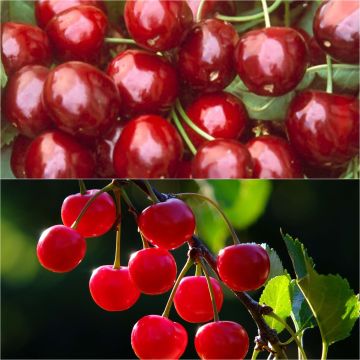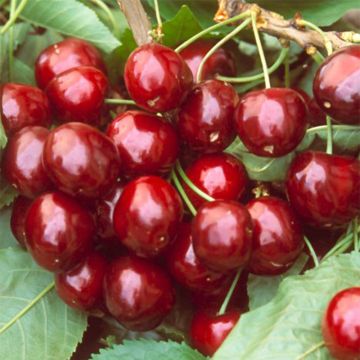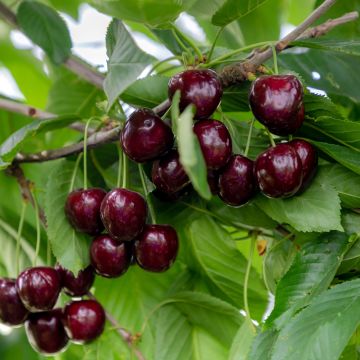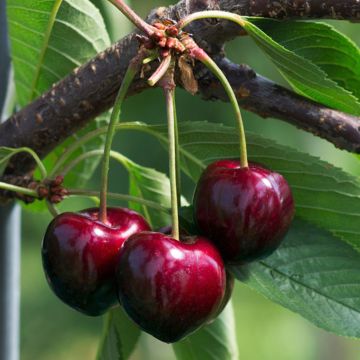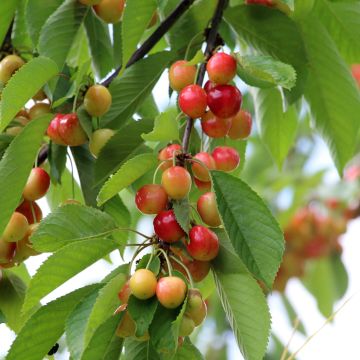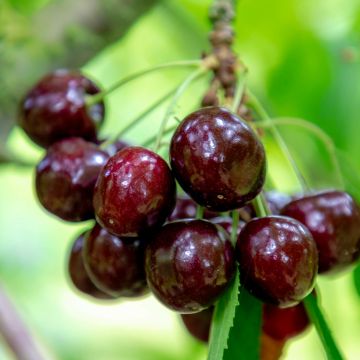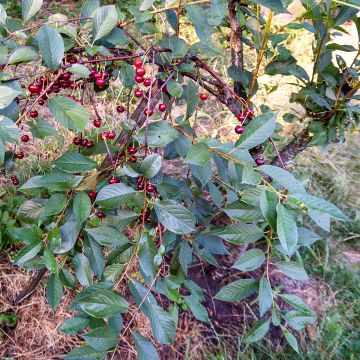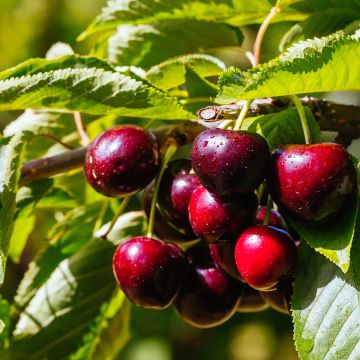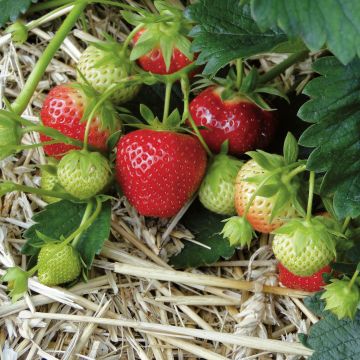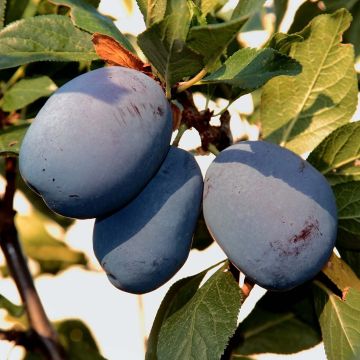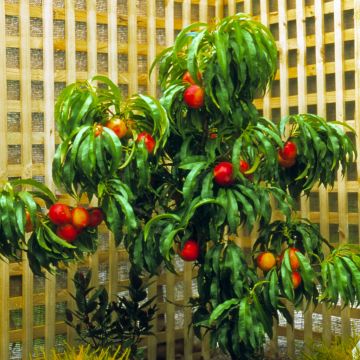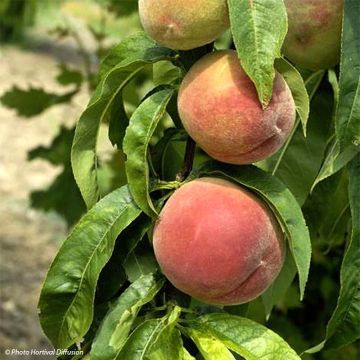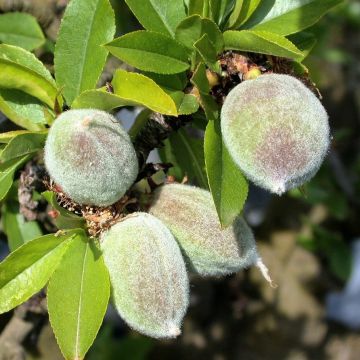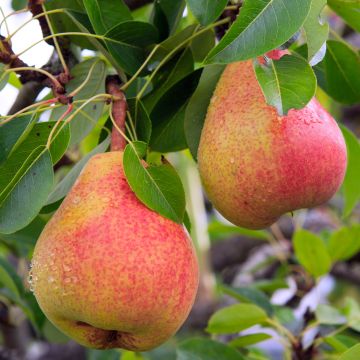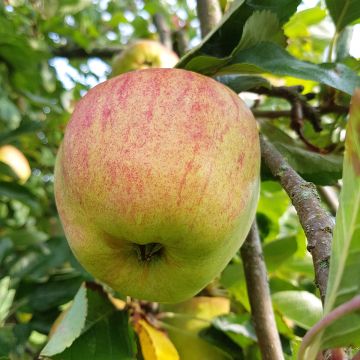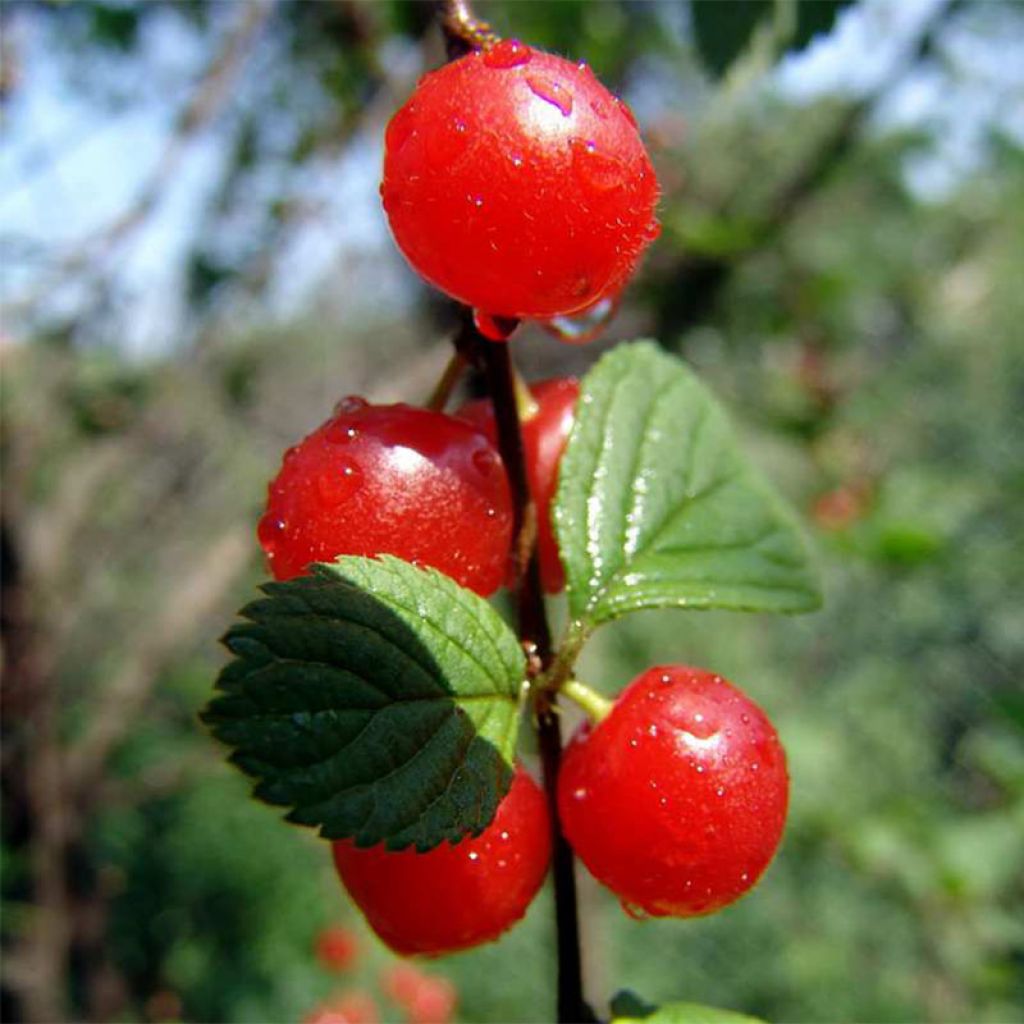

Prunus avium Sylvia - Cherry Tree
Prunus avium Sylvia - Cherry Tree
Prunus avium Sylvia
Wild Cherry, Sweet Cherry, Bird Cherry
The delivery was incredibly fast, I was supposed to receive it 6 days after my purchase and I actually received it only 3 days later! I don't know if the delivery men took care of this order, but the tree has no damage and it already has leaves! I'm super happy with my purchase!
Camille, 27/04/2024
Special offer!
Receive a €20 voucher for any order over €90 (excluding delivery costs, credit notes, and plastic-free options)!
1- Add your favorite plants to your cart.
2- Once you have reached €90, confirm your order (you can even choose the delivery date!).
3- As soon as your order is shipped, you will receive an email containing your voucher code, valid for 3 months (90 days).
Your voucher is unique and can only be used once, for any order with a minimum value of €20, excluding delivery costs.
Can be combined with other current offers, non-divisible and non-refundable.
Home or relay delivery (depending on size and destination)
Schedule delivery date,
and select date in basket
This plant carries a 6 months recovery warranty
More information
We guarantee the quality of our plants for a full growing cycle, and will replace at our expense any plant that fails to recover under normal climatic and planting conditions.
Description
The Sylvia Columnar Cherry Tree is a variety of dwarf Cherry Tree with a columnar habit, perfect for small spaces. It produces easy-to-pick, elongated fruits with a bright red skin and a sweet, crisp flesh. Flowering starts in April. It is a self-fertile variety, not requiring another variety for pollination. This variety will reach a height of 1.50 m (5ft) and a width of 50 cm (20in), and can be grown in both pots and in the ground. It is best planted in autumn for a harvest in July.
The Sylvia Columnar Cherry Tree produces elongated fruits with a sweet, crisp flesh and a bright red skin. Enjoy them right after picking or, if the harvest is abundant, use them to make pies, clafoutis, jams, and preserves. Cherries are rich in vitamin C, minerals, and trace elements.
The Sylvia variety has a columnar habit, perfectly suited for growing in pots or small spaces. Starting in April, the Sylvia Columnar Cherry Tree is covered in small white flowers that appear before the leaves. This variety is self-fertile and does not need to be associated with another variety for pollination. The Sylvia variety is harvested in July. The harvest can be more or less abundant depending on the year and may exhibit alternate bearing, allowing the bush to replenish its reserves.
The Sylvia Columnar Cherry Tree (Prunus avium) belongs to the Rosaceae family. It is a shrub with a columnar habit, consisting of a main branch and short, low-vigor lateral branches. This dwarf Cherry Tree reaches a height of 1.50 m (5ft) at maturity and a width of 50 cm (20in). Like other Cherry varieties, its dentate alternate leaves are shiny and dark green, turning a lovely reddish color in autumn before falling. The dwarf Cherry Tree can be grown in a pot on a balcony or terrace, or in the ground as a hedge or border plant. It is hardy and can withstand cold temperatures, but may need protection if grown in a pot.
Prunus avium Sylvia - Cherry Tree in pictures
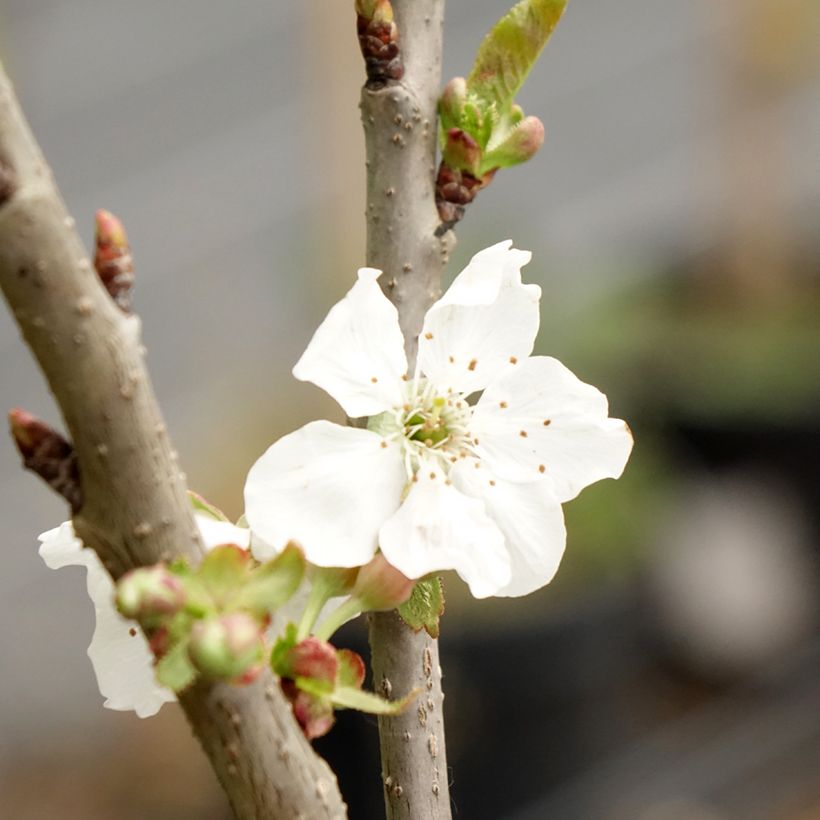

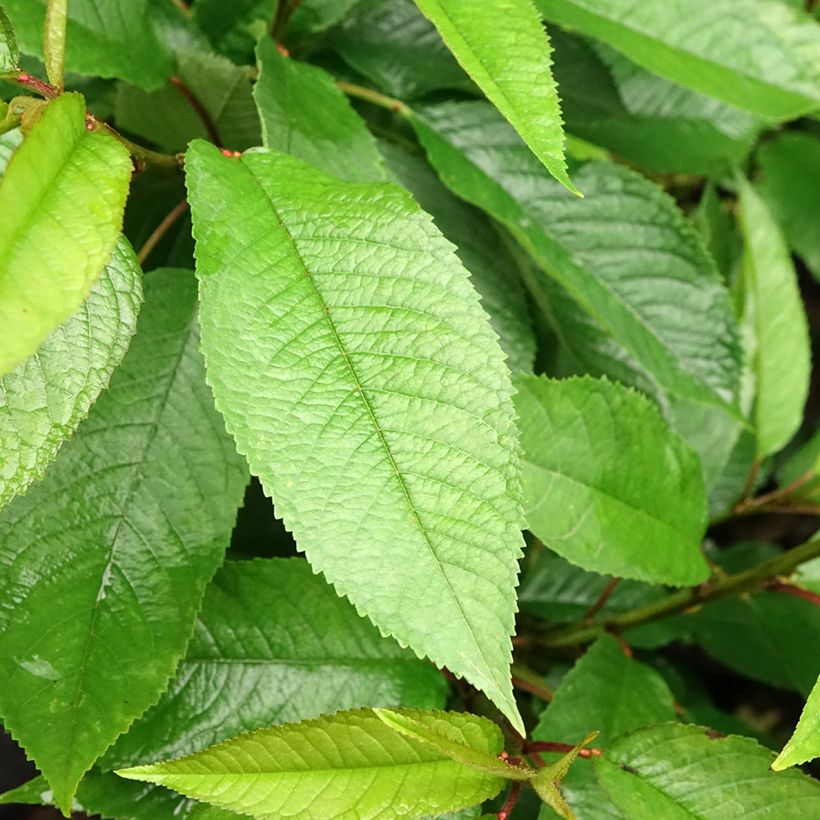

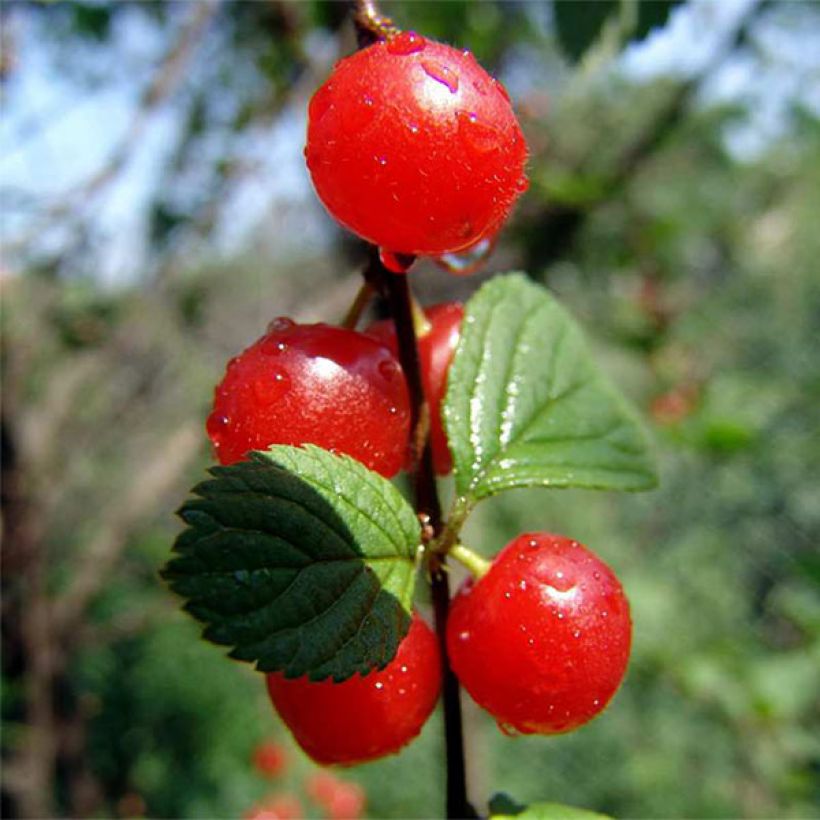

Plant habit
Fruit
Flowering
Foliage
Botanical data
Prunus
avium
Sylvia
Rosaceae
Wild Cherry, Sweet Cherry, Bird Cherry
Cultivar or hybrid
Other Cherry trees
View all →Planting and care
Easy to grow, the Cherry tree thrives in all types of soil, whether acidic or chalky. It prefers moist, light soils and dislikes heavy, clayey soils. Choose a sunny location. To reduce the risk of late frosts on the flowers, it is recommended to plant the Cherry tree in a sheltered position, facing west and protected from cold winds in regions that experience spring frosts. Planting is preferably done in autumn. If you plant multiple trees, space them 1 meter (3 feet) apart for dwarf varieties.
Loosen the soil deeply, remove rocks and unwanted weeds. Add some sand to improve drainage. Dig a hole 4 to 5 times the volume of the root ball. Make sure to separate the subsoil from the topsoil. Mix crushed horn or well-rotted compost or potting soil with the subsoil and pour this mixture into the planting hole. Place the root ball, cover with topsoil, and firm it down well. Water generously (about 10L).
During cultivation, watering is not necessary except in case of extreme heat. Mulch at the base to retain moisture in summer. Protect your harvest by installing either a bird net, aluminum foil, or old CDs. In case of aphid attack, spray water with black soap.
For pot cultivation: place a layer of gravel or clay pellets at the bottom of the pot to facilitate drainage. Add a layer of soil and then place the young plant, covering it with a mixture of 2/3 garden soil and 1/3 well-rotted compost or potting soil. Every spring, replace the top layer with fresh potting soil. Water regularly and moderately. At the end of autumn, protect the pot with insulation before winter frosts.
Planting period
Intended location
Care
Planting & care advice
-
, onOrder confirmed
Reply from on Promesse de fleurs
Similar products
Haven't found what you were looking for?
Hardiness is the lowest winter temperature a plant can endure without suffering serious damage or even dying. However, hardiness is affected by location (a sheltered area, such as a patio), protection (winter cover) and soil type (hardiness is improved by well-drained soil).

Photo Sharing Terms & Conditions
In order to encourage gardeners to interact and share their experiences, Promesse de fleurs offers various media enabling content to be uploaded onto its Site - in particular via the ‘Photo sharing’ module.
The User agrees to refrain from:
- Posting any content that is illegal, prejudicial, insulting, racist, inciteful to hatred, revisionist, contrary to public decency, that infringes on privacy or on the privacy rights of third parties, in particular the publicity rights of persons and goods, intellectual property rights, or the right to privacy.
- Submitting content on behalf of a third party;
- Impersonate the identity of a third party and/or publish any personal information about a third party;
In general, the User undertakes to refrain from any unethical behaviour.
All Content (in particular text, comments, files, images, photos, videos, creative works, etc.), which may be subject to property or intellectual property rights, image or other private rights, shall remain the property of the User, subject to the limited rights granted by the terms of the licence granted by Promesse de fleurs as stated below. Users are at liberty to publish or not to publish such Content on the Site, notably via the ‘Photo Sharing’ facility, and accept that this Content shall be made public and freely accessible, notably on the Internet.
Users further acknowledge, undertake to have ,and guarantee that they hold all necessary rights and permissions to publish such material on the Site, in particular with regard to the legislation in force pertaining to any privacy, property, intellectual property, image, or contractual rights, or rights of any other nature. By publishing such Content on the Site, Users acknowledge accepting full liability as publishers of the Content within the meaning of the law, and grant Promesse de fleurs, free of charge, an inclusive, worldwide licence for the said Content for the entire duration of its publication, including all reproduction, representation, up/downloading, displaying, performing, transmission, and storage rights.
Users also grant permission for their name to be linked to the Content and accept that this link may not always be made available.
By engaging in posting material, Users consent to their Content becoming automatically accessible on the Internet, in particular on other sites and/or blogs and/or web pages of the Promesse de fleurs site, including in particular social pages and the Promesse de fleurs catalogue.
Users may secure the removal of entrusted content free of charge by issuing a simple request via our contact form.
The flowering period indicated on our website applies to countries and regions located in USDA zone 8 (France, the United Kingdom, Ireland, the Netherlands, etc.)
It will vary according to where you live:
- In zones 9 to 10 (Italy, Spain, Greece, etc.), flowering will occur about 2 to 4 weeks earlier.
- In zones 6 to 7 (Germany, Poland, Slovenia, and lower mountainous regions), flowering will be delayed by 2 to 3 weeks.
- In zone 5 (Central Europe, Scandinavia), blooming will be delayed by 3 to 5 weeks.
In temperate climates, pruning of spring-flowering shrubs (forsythia, spireas, etc.) should be done just after flowering.
Pruning of summer-flowering shrubs (Indian Lilac, Perovskia, etc.) can be done in winter or spring.
In cold regions as well as with frost-sensitive plants, avoid pruning too early when severe frosts may still occur.
The planting period indicated on our website applies to countries and regions located in USDA zone 8 (France, United Kingdom, Ireland, Netherlands).
It will vary according to where you live:
- In Mediterranean zones (Marseille, Madrid, Milan, etc.), autumn and winter are the best planting periods.
- In continental zones (Strasbourg, Munich, Vienna, etc.), delay planting by 2 to 3 weeks in spring and bring it forward by 2 to 4 weeks in autumn.
- In mountainous regions (the Alps, Pyrenees, Carpathians, etc.), it is best to plant in late spring (May-June) or late summer (August-September).
The harvesting period indicated on our website applies to countries and regions in USDA zone 8 (France, England, Ireland, the Netherlands).
In colder areas (Scandinavia, Poland, Austria...) fruit and vegetable harvests are likely to be delayed by 3-4 weeks.
In warmer areas (Italy, Spain, Greece, etc.), harvesting will probably take place earlier, depending on weather conditions.
The sowing periods indicated on our website apply to countries and regions within USDA Zone 8 (France, UK, Ireland, Netherlands).
In colder areas (Scandinavia, Poland, Austria...), delay any outdoor sowing by 3-4 weeks, or sow under glass.
In warmer climes (Italy, Spain, Greece, etc.), bring outdoor sowing forward by a few weeks.































